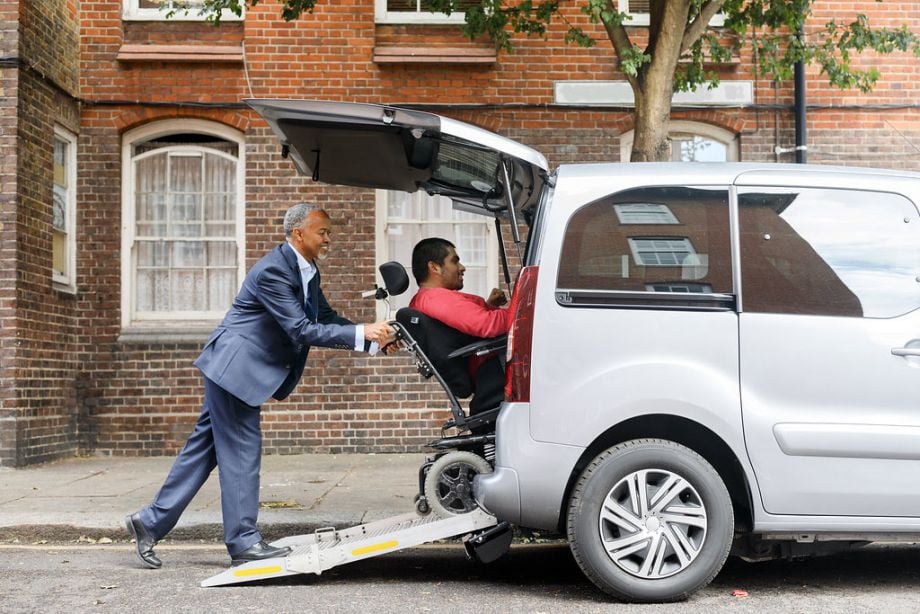From getting clients to eye appointments in rural geographies to more regular transportation to everything from food banks to regular case management appointments, nonprofits have their transportation work cut out for them. Through a patchwork of resources like public transportation and volunteer rides, most nonprofits can get many of their transportation needs met, but rarely all of them. What about those left behind?
Many nonprofits have begun to use ride hailing services like Uber and Lyft to fill in the gaps by coordinating rides for their clients, but because the platforms weren’t designed to meet this need, it can be a complicated and costly endeavor. “It’s not as easy as handing people cash to get a ride,” explains Staci Sahoo, director of mobility management at Hopelink, a Redmond, Washington-based nonprofit. However, the services do add a unique value. “They fill a gap. We had someone experiencing vision loss,” she says of an instance where Hopelink used ride hailing services for a client who needed to get to an eye doctor. “It really did change my perception of where they can fill in a gap.”
As of 2016 there were approximately 1.54 million nonprofits like Sahoo’s registered with the IRS, amounting to a 4.5% increase from 2006. From food security to housing to health care, U.S. nonprofits provide essential services across the country. But in order to serve people, people have to be able to get to where the nonprofits are — a challenge in areas where people may not own cars or have access to reliable public transportation.
That’s why many nonprofits are offering and arranging transportation for their clients through ride-hailing services like Uber and Lyft. A new report aims to shed light on the role that ride-hailing services play in making nonprofit offerings accessible.
Dyana Mason, an assistant professor at the School of Planning, Public Policy and Management at the University of Oregon, co-authored the study, funded in part by the National Institute for Transportation and Communities.
“What brought me to this research is that cities may be facing pretty dramatic changes over the next 10, 20, 30 years as new technologies,” like self-driving cars, “are implemented,” she says. “I just wanted to make sure that folks who already struggle with access to transportation aren’t further left behind as policymakers and planners are thinking about how to revise their transit systems.”
Overall, Mason’s study, conducted in the Seattle region, found that ride hailing services are absolutely used by nonprofits as one way to arrange transportation for clients, but that there are several obstacles that stand in the way from them becoming as used and useful as they could be, chiefly cost. The use of ride hailing services in many instances relies on subsidies in various forms, from grant funding to direct partnerships with Uber or Lyft, to make them an affordable option for many nonprofits. Otherwise, rides can cost up to $50 or more, which quickly becomes cost prohibitive for small nonprofits or their clients.
One participant in Mason’s study, who has a disability, told her:
“The benefit of Uber was so, so important because I wouldn’t have to deal with the physical exhaustion of having stood up for the first hour of my day. Like, you know, you’re barely awake and it’s just not a good time. So, um, even though it was costing me — and it’s like an obscene amount, like $400 a month on an average month — I was more than happy to do that because of the benefits that it gave me physically to not have to use the train.”
Mason discovered that nonprofits are spending a significant amount of time helping their clients use ride-hailing, as well. “One thing I found is, because of the way ride hailing services are being used right now, they require a lot of capacity in terms of staff time for the organization to use their services,” Mason says.
That’s often because nonprofits have to help coordinate rides for clients who don’t have smartphones. The nonprofit books the ride on behalf of the client and may need to troubleshoot any issues along the way, from traffic delays to changes in pick-up locations.
Sahoo says that she has seen the issue of tech access crop up a lot during the current vaccination program they’re running. Hope Link is working to get community members to vaccination sites through a variety of transportation options, one of which is ride hailing services.
“We stood up a vaccine helpline where we’ve been coordinating vaccination rides,” she explains. “Especially for older people who speak a different language, there’s still a lot of hand holding that needs to take place.”
She also says that accessibility can be another hurdle since there aren’t many wheelchair-accessible Uber and Lyft vehicles out there. (Uber and Lyft have been sued in multiple cities for not providing enough wheelchair accessible vehicles, or after incidents where drivers refused to help wheelchair users.) , but she’s also quick to note the benefits of using ride hailing services, too — chiefly that they fill in gaps left by existing transportation options. “We’re thankful for them. There is a role that they play in the community, but they can’t serve everyone so how do we have them play that role as opposed to being a central provider?”
For Sahoo, it comes down to money. “One of the takeaways that I got from the research was that we not only need the funds to offer [ride hailing services] to nonprofits, but I’d argue that it maybe needs to go a step further,” she says. “Funds are great, I’ll never say no to money, but flexibility with existing funding would be great,” Sahoo adds, explaining that if using money for ride hailing was an acceptable use of other transportation funding, groups like hers would be able to make the most out of all of the options available.
Ultimately the report offers several recommendations: the development of trainings by philanthropic organizations for nonprofits to learn best practices for offering ride-hailing services, additional funding for offering ride hailing services specifically, and supporting ride-hailing companies in the development of both accessible transportation options and the development of interfaces and promo codes specifically for nonprofit use.
While this study is new, both Mason and Sahoo expect interest in the area to only increase as transportation evolves in the future.
“I think [ride hailing services] could be more useful,” Mason says. “My study found that nonprofits do use them to support their client’s needs, but there are obstacles to really making it a large part of their work and the main one is money.”
“It’s not a one-size-fits-all situation,” Sahoo says. “Everyone’s transportation needs are extremely unique, and we need to make sure that they get the right transportation to suit their needs.”

Cinnamon Janzer is a freelance journalist based in Minneapolis. Her work has appeared in National Geographic, U.S. News & World Report, Rewire.news, and more. She holds an MA in Social Design, with a specialization in intervention design, from the Maryland Institute College of Art and a BA in Cultural Anthropology and Fine Art from the University of Minnesota, Twin Cities.
Follow Cinnamon .(JavaScript must be enabled to view this email address)














